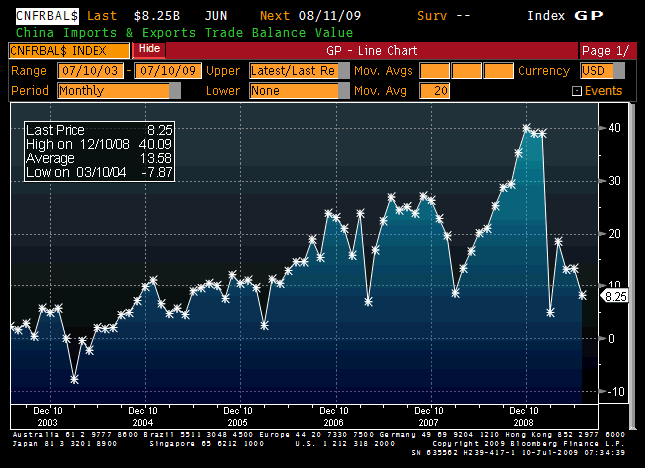Chinese Handcuffs? No, Chinese trade deficit
More on:
This is Mark Dow. Brad is away.
China has become the obsession that Japan was back in the 80s. And rightly so. It is a huge place, with a robust secular growth force underlying it (remember the conditional convergence growth hypothesis?). Rumors of China doing this or that have become a daily staple of the market.
Lately, the discussion has focused a lot on their willingness to continue to buy US treasuries. I know Brad does a lot of good work on this issue in this space. Much less attention, it seems to me, has been placed on their need to buy more Treasuries.
It has long been my contention that the large global imbalances were mostly a function of risk appetite and financial innovation leading to an explosion of the money multipliers all over the world—especially in countries with a greater degree of financial sophistication and/or capital account openness (I almost said promiscuity).
Here in the US, we were the leaders. It had less to do with Greenspan, less to do with Congress, Fannie Mae, and Freddie Mac, and more to do with the private sector taking excessive financial risk. After all, it was a global phenomenon. Over the course of history this tends to happen any time there is a period of macroeconomic stability coupled with the observation that others around us are making money. People tend to pile on and take things too far. It is in our very nature. (I would recommend Akerlof and Shiller’s “Animal Spirits”, or Kindleberger’s “Manias, Panics, and Crashes” for anyone interested in these behavioral phenomena).
In this case, it led to a huge trade imbalance with China. Credit allowed us to consume beyond our means, and demand spilled out over our borders into China. The Chinese obliged and became huge holders of Treasuries. While it is true that the Chinese exchange rate regime was an amplifier of this story, I think it was more of a passenger than a driver. The driver was credit.
Today the credit bubble is popping (whence my view on inflation and the money multiplier). At the same time the Chinese are trying to prop up aggregate demand by controlling the only thing they can: domestic demand. This to me means the imbalances are in the process of going away. In fact, I have long said (and have made a few bets with friends) that the Chinese trade balance will likely be in deficit by the end of this year. This means that the need for China to buy our treasuries will have largely gone away. I realize this may be too aggressive a contention over this time frame, but I am convinced the basic story is right. And to my mind’s eye there isn’t an exchange rate regime or Renminbi level that can stop this from happening.
On Monday I posted a chart of the US trade balance, and we saw in it the dramatic swing that took hold as soon as the credit bubble popped. Overnight, the Chinese trade balance figures came out. Have a look at the chart below.

The chart shows China’s monthly trade balance. You will note that every year around March there is a big dip. It is a seasonal anomaly associated with the Chinese New Year. What you will observe is that the post-Chinese New Year rebound this year was much less pronounced, and, unlike in previous years, it soon rolled over. The trend now appears to be going the other way. This is despite Chinese government incentive to support exports and China increasingly taking market share from other Asian countries. It may well turn out that quite soon a Chinese trade deficit will have allowed us to slip out of—at least from a flow perspective—our Chinese handcuffs.
More on:
 Online Store
Online Store
